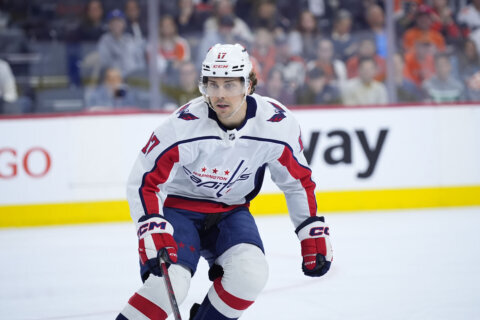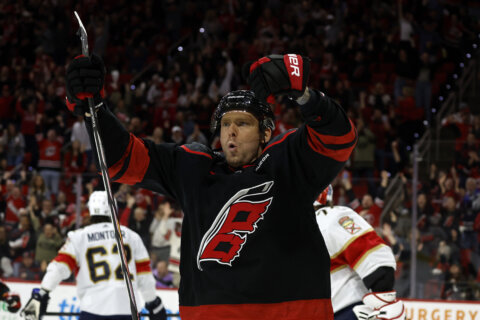WASHINGTON — Most of us probably think of the mumps as a childhood disease, an ailment from a generation ago all but eradicated by our vaccinations. But a recent outbreak of the disease at the highest level of professional sports is a reminder of just how easily the disease can spread, and has brought to light the question of just how effective the vaccines for viruses like this are in building up our immunity to them.
For those unfamiliar with the story, at least 20 NHL players on six or more teams have been diagnosed with the mumps this season, most notably Pittsburgh Penguins star Sidney Crosby. Crosby unwittingly became the face of the outbreak when he appeared with severely swollen cheeks at a press conference last Friday while denying he had the disease, only for later tests to confirm that he was, in fact, infected. The outbreak is scary not only because of the seriousness of the symptoms, but because the entire epidemic seemingly came out of nowhere.
There were just 438 reported cases of the mumps in the U.S. last year, and just 229 in 2012, according to the Centers for Disease Control. That means just better than one out of every one million people comes down with the virus.
“This is the most surprising sports medicine story of the year,” says Dr. Matt McCarthy, an assistant professor of medicine at Weill Cornell Medical College and an assistant attending physician at New York-Presbyterian Hospital. “There’s not a close second on this.”
McCarthy — who writes a medical column for Deadspin and has a book, “The Real Doctor Will See You Shortly,” coming out April 7 — says there are more cases on the Minnesota Wild alone than he’s seen in his entire medical career.
This is hardly the first epidemic of infectious disease to strike a professional locker room. Just last year, the Tampa Bay Buccaneers scrambled to contain a MRSA outbreak, otherwise known as a staph infection, which affected at least three players.
In 2009, the San Diego Padres Triple-A affiliate in Portland, Oregon, was struck with influenza, which some worried might have been swine flu, as a couple of the infected players had recently been promoted from Double-A San Antonio, where there had been confirmed cases. The players were quarantined in their rooms in a Salt Lake City hotel and a game was canceled while they received treatment.
While mumps is also viral, this outbreak is different because it takes longer than a common cold or infection to begin to show symptoms.
“This is so rare, we have to draw on the other outbreaks,” says McCarthy. The most comparable recent outbreak that has the same type of gestation period is Ebola. Patients often go a week or more after infection before displaying symptoms. This can make the mumps especially tough to manage in general, and even more so when patients are members of a traveling team.

The mumps outbreak is also different because it is a disease we all assume we’ve been immunized from. Questions immediately arose about whether some of the foreign players in the NHL hadn’t been subjected to the same standards of vaccines as children in their home countries as North American players had. But that rumor was quickly dispelled.
“When they were tested, the players actually had antibodies in their system,” says McCarthy. “Their immunity is just wearing off faster than we thought.”
That’s where this story can get scarier. If players who have received their shots can still get sick, isn’t anyone susceptible? And isn’t it more of a surprise, then, that it has taken this long for such an outbreak to occur?
“It really is,” says McCarthy. “And the big thing that we’re learning is the false sense of security we have about vaccines.”
Mumps is commonly spread through saliva. Dr. Judith Aberg, the chief of infectious diseases at Mt. Sinai Hospital, thinks that hockey’s close contact and hard hits are cause for the disease to spread. But football and basketball have similar contact and proximity. Beyond that, players share the same close contact with teammates and opponents, not to mention the same showers and locker rooms, the same team buses and airplanes.
“It could easily slip into another sport, especially if these athletes mingle socially,” says McCarthy. “They are just as susceptible in the NFL or NBA.”
Before any parents freak out and pull their kids from mites hockey or Pop Warner leagues, there is good news for youth sports. The last major American mumps outbreak happened in 2006, at several Midwestern colleges. Doctors found that antibodies to the disease were much stronger in those who had been vaccinated within the last five years, compared with those who had been vaccinated 15 years earlier. As the standard American MMR (measles, mumps, rubella) vaccination cycle includes boosters at age one and five, children should have much stronger immunities than adults.
“A second grader is a lot closer to that vaccine than a 28-year-old that skates for the Penguins,” says McCarthy, but he couches his statement by saying that that doesn’t mean you shouldn’t ask your pediatrician if you have concerns, or want to learn more about risk factors.
As for the NHL, McCarthy says, the best recourse is to offer not only all players, but all staff that interact with them in the locker rooms and on the ice, a new vaccination. Only time will tell whether the vaccines are producing adequate antibodies to fight off the mumps or we need to change our approach to how we prevent the spread of the disease.
Follow @WTOP and @WTOPSports on Twitter and WTOP on Facebook.







